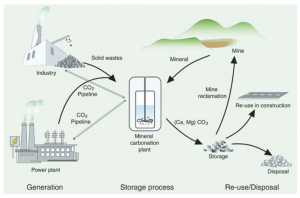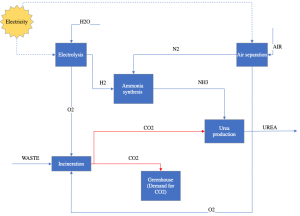General information
Type: Master project
Period: Spring 2021
Project directors: Prof. François Maréchal (IPESE-EPFL)
Assistants: Rafael de Castro Amoedo (IPESE-EPFL)
Related project: Waste integration and valorization
Introduction
The world is facing a dual challenge with regard to sustainable energy supply and greenhouse gas emissions reduction. The complexity consists in supplying more abundant and clean energy, consuming fewer fossil resources and finding appropriate solutions to reduce emissions while satisfying the energy requirements. Between the first oil crisis and 2010, global CO2 emissions doubled and until 2035 an additional increase of 23% is predicted due to the growing population and energy consumption.
To meet the CO2 reduction targets and to ensure a reliable energy supply, the development and wide scale deployment of cost-competitive innovative low-carbon energy technologies is essential. Switching to renewable resources and CO2 capture, utilization and storage (CCUS), are regarded as promising alternatives. To design and evaluate the competitiveness of such complex integrated energy conversion systems, a systematic comparison including thermodynamic, economic and environmental considerations is required.
Waste generation, an often sub-valorized resource, is in clear growth. Rapid urbanization and increasing population are pressuring the use of resources and the growth of waste generation in the near future. Depending on the composition, average municipal solid waste (MSW) energy content is close to 12 MJ/kg, part of which can be retrieved as heat and electricity in thermovalorisation units. Nevertheless, these units emit a considerable amount of CO2 – a carbon source that could be used if CCUS technologies are deployed.
Technologies for CO2 capture are relatively well understood today with cases of industrial success. However, capture and storage are not enough; an utilisation phase is seen as fundamental to replace processes in which fossil fuels, or fossil-based resources are used. The current conviction is that CCUS technologies have to be pursued. To understand entirely the role the different CCUS schemes could play in reducing greenhouse gas emissions, a number of issues need to be addressed simultaneously – like the assessment of all resulting emissions, the energy requirement and the costs of implementation.
To identify process improvements and optimal process designs it is important to make a consistent comparison using the same methodology and uniform assumptions, and to take into consideration multiple criteria simultaneously. In doing so, different process options can be evaluated against each other and ranked for decision-making. When process designs are only evaluated with regard to one criterion, for example operating costs, there is a risk to promote inefficient and environmentally harmful configurations. Consequently, process competitiveness needs to be rated by multiple criteria. Process integration maximising heat recovery and minimising energy losses is also inevitable. Therefore, the development of a comprehensive comparison framework for waste management processes comparison and optimisation is needed.
GOAL
A systematic thermo-environomic optimisation strategy for the consistent modelling, comparison and optimisation of waste treatment options is being developed. Based on the application of a consistent evaluation and optimisation methodology, this work intends to study and understand the competing energetic, economic and environmental costs of carbon capture, storage and utilization for greenhouse gas mitigation and sustainable energy supply in actual and future energy systems. It is focused on municipal solid waste as feedstock, comprising all its different components.
The choice of the optimal configuration is defined by the production scope and the priorities given to the different thermo-environomic criteria. The environmental benefit and the energetic and economic costs of carbon capture should be assessed for several process options and energy systems, for different CO2 capture technologies. The process performance is systematically compared and the trade-offs are assessed to support decision-making and identify optimal process configurations with regard to the polygeneration of fuels, electricity, heat and captured CO2, identifying its advantages and constraints, and to better understand the trade-offs between efficiency, investment and emissions.
The approach will be systematic and provides a fast, comprehensive and optimal reassessment of design options when conditions change – incorporating the seasonal behaviour of waste composition and heat demand. A methodology able to generate optimal process configurations by taking into account the thermodynamic efficiencies based on process integration techniques, the economic performance and the environmental impacts from LCA results will be beneficial from a sustainability and process engineering point of view to identify possibilities to enhance the competitiveness of waste thermovalorisation units with CCUS.
This work aims to contribute to the following questions:
- What is the cost of treating waste, comprising CCUS?
- What causes the trade-off between the different objectives and what are the consequences on decision-making?
- What is the influence of technology choice and the economic scenario?
- What is the benefit of process integration implementation? Use of Heat pumps (e.g.)
- What is the effect of the installation size?
- What are the bottlenecks of these technologies to penetrate the market?
TOOLS
A library of models is available comprising different conversion routes for waste. In particular, thermovalorisation models (incineration, gasification, pyrolysis, etc.), district heating models, CO2 capture units and use of CO2 to produce C1-chemicals (methanol, methane, formic acid, carbon monoxide) are available. In addition, utility/combustion models (steam network, heat pumps, SOFC, Gas turbines, SOEC, etc.) are available.
Key points:
- Development of Urea production models from CO2 and NH3.
- Development of Greenhouses models for vegetable production (using CO2 as growth promoter)
- Continue the development of CO2 mineralization models: Magnesium or Calcium oxides found in combination with silicates (serpentine, olivine, etc.) are materials that can be used to store CO2 in a long-lasting format (MgCO3 and CaCO3) and can be incorporated in construction materials while co-producing SiO2 that can be used as cement replacer due to its pozzolanic properties. In addition, waste slag can be used as mineralization substrate, due to the high concentration of Calcium Oxide.
- Incorporate previously developed models according to the needs and suitability.
- Possibility of industrial collaboration with current partners.


Workflow:
- Framework: comprehensive structure of models to address CO2 released from waste treatment options
- Modelling approach: Flowsheet (Aspen/Vali) for process modelling to represent the chemical and physical transformations and/or black-box/surrogate models.
- Energy integration: by making use of pinch analysis, it will be shown how the process integration impacts the process configuration, with opportunities for maximizing and valorizing waste heat.
- Economic and environmental analysis – addresses how a carbon tax could be implemented and its value, as well as the impact of adding CCUS.
- Multi-objective optimization – to assess trade-offs between conflicting objectives, including efficiency metrics, capture and utilization costs, etc.
- Results analysis and conclusions, answering the main questions.
You should bring…
- Experience in working with flowsheeting software is a plus (Belsim Vali, Aspen) or motivation to improve your skills
- Experience in programming languages (e.g. Matlab, Lua, python, etc.)
- Good knowledge of energy systems (Some EPFL classes like: Thermo I/II, Energy conversion, advanced energetics, MOES, etc.)
- A high level of motivation to work independently in a structured and organized way
- Good communication skills
We also offer…
- Scientifically rich research environment with researchers from different areas
- Dynamic research group
- EPFL-Valais promotes sports and language classes to its members.
- Financial compensation to travels from Lausanne to Sion.
How to apply
If interested, please take contact with Rafael Amoedo attaching your CV, Cover Letter and transcript of records (Bachelor’s and Master’s).
Practical information
The IPESE laboratory is located in the Sion EPFL campus. Travels from Lausanne to Sion are compensated by EPFL.